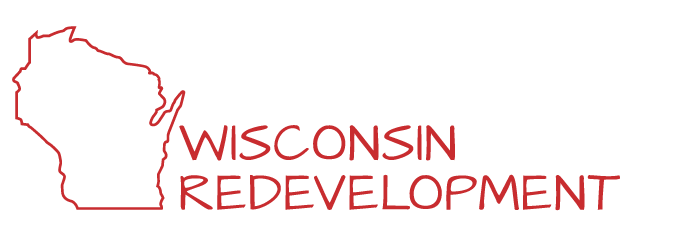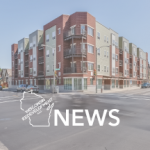By David Aquilina, Contributing Writer
Milwaukee—Located in an inner-city neighborhood in Milwaukee at South 35th Street and West National Avenue—and topped off by a distinctive green roof installation—Silver City Townhomes includes 20 1,500-1,900-square-foot rent-to-own, three- and four-bedroom townhomes. Co-developed by Layton Boulevard West Neighbors Inc. (LBWN), a non-profit community development organization, and Wisconsin Redevelopment LLC, a real estate development and consulting firm, the $5.2 million project consists of five buildings with four multi-story townhomes in each building. The units feature private entries and welcoming front porches as well as attached private garages.
Developed to provide high-quality, affordable housing for working families earning between 50-60 percent of Milwaukee County’s median income, the project injects new vitality into the neighborhood. Silver City Townhomes won a Milwaukee Award for Neighborhood Development Innovation (MANDI). Sponsored by U.S. Bank, in partnership with Local Initiatives Support Corporation (LISC) Milwaukee, the MANDIs recognize efforts to strengthen Milwaukee’s central city neighborhoods.
Designed by Quorum Architects Inc. and built by Universal Construction Solutions, Silver City is an urban infill development totaling 42,000 square feet. Constructed on land once occupied by vacant parking lots and dilapidated sports courts, the project is a model of energy efficiency and low-impact design. High-efficiency HVAC systems provide forced-air heat and central air conditioning. The units include a complete ENERGY STAR kitchen appliance package (stove, refrigerator, microwave, dishwasher and disposal), and the in-unit laundry rooms feature ENERGY STAR washers and dryers. The interiors incorporate low-VOC cabinetry, paints, woodwork and carpeting.
The five green roofs, each measuring 2,315 square feet, were funded with a $172,278 grant from the Metropolitan Milwaukee Sewerage District (MMSD) and installed by Gibraltar Landscape and Construction LLC using the Xero Flor Green Roof System. The green roofs form part of the development’s stormwater system. According to Mark Knapp, AIA, a principal with Quorum Architects Inc., they stand out as the project’s signature green building element. The green roof installation is unusual in that the roofs are visible at eye level from the 35th Street Viaduct adjacent to the townhomes.
Storm water challenges
Like many older cities in the United States, Milwaukee still contends with the environmental problems from a combined sewer system for stormwater and wastewater. Heavy rains overtax the system and send a polluted overflow of stormwater and sewage into the Milwaukee River and Lake Michigan. MMSD’s grant program for green roofs is part of the region’s efforts to protect and improve water quality.
As an urban in-fill project, Silver City had little space at ground level for stormwater mitigation features such as bio-swales or permeable pavement. The townhomes were built on a site with existing basketball and tennis courts. Community members advocated for these amenities to be replaced and maintained open to the public. As a condition of the sale of the site for the project, the City of Milwaukee did require the replacement of the courts. That further limited the space available at grade for stormwater features.
“Below-grade retention with culverts under the parking area plus the green roofs on top of the buildings was the most feasible solution because of the space limitations at ground level on the site,” says Robert O. Lemke, AIA, LEED AP, professor of architecture, Milwaukee School of Engineering (MSOE) and president, Wisconsin Redevelopment, LLC.
“Given the location, with the green roofs at the same level as the roadway on the viaduct, this project gave MMSD and everyone involved a unique opportunity to showcase green roofs and their benefits for sustainability,” Knapp says.
Green roof solution
Knapp and Quorum Architects designed the townhomes with wood frame construction. Thus, in selecting a green roof system, being lightweight was a key consideration in order to minimize the structural requirements and costs to accommodate the added weight.
According to Lemke, Silver City was Wisconsin Redevelopment’s first green roof project. Therefore, he thought it was important to go with a system with a record of success.
Both Knapp and Lemke agreed that ease of installation and minimal long-term maintenance requirements were also significant factors.
Based on the recommendation of Dave Waldhuetter, president of Universal Construction Solutions, the project team selected the Xero Flor Green Roof System from Xero Flor America (XFA). Xero Flor is a lightweight system that utilizes pre-vegetated mats.
For the Silver City project, XFA recommended installing the Xero Flor XF301+2FL system option. The system’s pre-vegetated green roof mats are an integrated unit of plant material and 1.75 inches of an engineered, lightweight aggregate growing medium on a permanent, flexible geotextile carrier. With this patented textile-based design, the plant material and 1.25 inches of growing medium are woven together into the underlying textile material.
The mats are installed with three system components: water retention fleece, a drain mat and a root barrier. In the option used for Silver City, two layers of .25-inch retention fleece (a blend of non-woven recycled synthetic materials) sit right under the pre-vegetated mats to facilitate distribution and storage of water within the root zone of the plants. The .75-inch drain mat is installed under the water retention fleeces. It allows excess water to flow to roof drains. Placed directly on the roof, the root barrier is a 20 mil. water-impermeable, low-density polyethylene layer that prevents root encroachment. With no additional growing medium, this system option weighs only 10-11 pounds per square foot when fully saturated.
“Silver City was my first green roof installation with this system. It was easy to learn,” Steve Maria, president, Gibraltar Landscape and Construction LLC, says. “The staff from Xero Flor America was very professional and worked right alongside us.”
Xero Flor pre-vegetated mats are grown in production fields on independent, locally owned farms located in the climate zone where they will be installed. Therefore, the plants are adapted to specific regional climates. They grow on the ground for a full nine to 12 months and are mature and well established before going up on the roof. Full-grown, regionally adapted plants are better able to thrive on the rooftop. That creates an instant green roof that will be successful and sustainable for the long term with low maintenance.
The pre-vegetative mats for Silver City were grown with the Xero Flor Upper Midwest U.S. Plant Mix, which includes multiple varieties of Sedum selected for regional suitability. Plant variety promotes diversity, supports a dynamic plant community on the rooftop and results in a green roof that adapts sustainably to the specific conditions of every project. Three varieties—Sedum ellacombianum, Sedum hybridum and Sedum spurium var coccineum—give the Silver City green roofs their distinctive reddish color in the fall.
Green roof results
The Silver City green roofs are effective in reducing the volume of stormwater runoff. Clayton Rugh, Ph.D., general manager and technical director of Xero Flor America (XFA), has calculated that the green roofs can retain up to a total of 6,500 gallons per rain event.
Green roofs shade and insulate the buildings’ roofs and keep rooftop temperatures in line with ambient air temperatures. Roof surfaces below the green roofs can even stay cooler than the air above.
By reducing the effects of the sun’s energy, the green roofs improve the townhomes’ thermal performance. “On average, the green roofs reduce tenants’ utility bills by 20 percent,” Lemke says.
The green roofs will also extend the service life of the townhomes’ structural roofs by serving as a shield that prevents UV radiation and temperature extremes from degrading roof components and protects them against damage from windblown debris. “The roofs should last at least two times longer than the typical exposed roof,” Rugh says. “That means the roofs could last up to 40-60 years, reducing long-term maintenance costs for the townhomes.”
And…what about those sheep on the roof? “We put plastic sheep up on the roof to draw attention to Silver City. It worked. People do notice them,” said Lemke. “The green roofs are so highly visible, they symbolize the project’s commitment to sustainability, make it stand out and helped market the project.”
For link to article from multihousingnews.com click here



